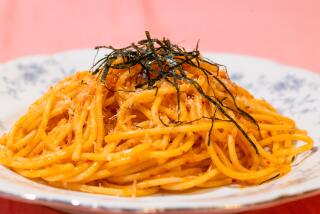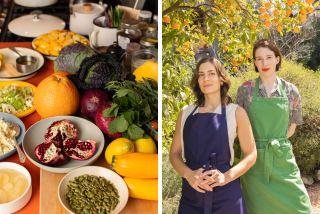An Early Spring : Confessions of a Pod Person
As a child, the only way I could eat peas was to pretend they were pills and swallow them whole, washed down with milk. Imaginary pneumonia, flu and intolerable insomnia were cured at the dinner table.
āIām taking a sleeping pill,ā Iād announce, then down the pea and produce great, grunty whistling snores until my mother said, āThatās just about enough, thank you.ā
Now I grow my own peas.
Last October, I bedded dried, shriveled pea seeds in damp rags and left them on my water heater. When they sent out inquisitive white roots, I planted them, one per inch, in my garden. I planted Sugar Snap edible pod peas and shelling peas with a transvestiteās name: Wando.
Wando peas, I read on the packet, needed support. When the vines got a little length on them, I stuck part of an old expandable wooden gate in the ground. The plants tried the gate--they twirled these heartbreakingly tiny tendrils around the wood--and let go, as if theyād decided instead to sprawl across the ground, flirt with the dark forces of rot and mildew. I kept introducing them to the gate without result. Peas, like teen-agers, often donāt know whatās best for them. Eventually, I tied them up. For their own good.
After some weeks, there was an outbreak of white flowers that looked like profiles of women in bonnets. These blossoms dried up and fell away to reveal inch-long green crescents. When the sun hit these crescents, tiny embryonic peas could be seen, rows of apostrophes. Next, the pods grew thick and the peas stayed tiny. Then the peas fattened up, filled out.
I opened pods of stunning symmetry--perfect green spheres with the tiniest hitch holding them to the pod. Thereās nothing dearer than peas in the pod, nothing in the vegetable kingdom at any rate. And theyāre so sweet, they taste already cooked.
I stumbled around my garden, popping peas. Reeling.
Around the time my Wandos were coming into their perfect selves I was reading āSimple Foodā by John Thorne. In his preface, Thorne writes about how recipes are only re-creations; the process of coming up with a recipe, with all its decisions and confusions, is not apparent to the cook who follows a recipe. However, as soon as cooks start comparing cookbooks with each other, they get a sense of how many decisions are inherent in the simplest recipe. To illustrate this point, Thorne introduces his readers to a particularly controversial and versatile dish: risi e bisi , rice and peas.
The controversy surrounding risi e bisi is based on what, exactly, risi e bisi is: soup or risotto. Thorne lines up the sides: Marcella Hazan and Ada Boni say risi e bisi is soup. Elizabeth David and Jane Grigson vote for risotto. A browse through the Italian cookbooks in any collection, even my own limited home collection, expands upon this controversy. Lorenza di Medici votes for soup, Gioletta Vitale puts rice and peas together in something closer to a pilaf.
Thorne, after sorting through a slew of risi e bisi permutations, presents his own recipe for a soup and a risotto. Both recipes contain the same ingredients and differ only in proportions.
Clearly, itās difficult to go wrong with the dish, given the ingredients: rice and peas in combination are inarguably pleasurable. Soup or risotto, risi e bisi can bear the imprint of any good cook and still be delicious--proof that there is no single path to the marvelous.
Thorne himself says, āEven if you have never heard of this dish before, you probably have some idea as to how you would go about making it.ā
Indeed.
I had enough of an idea that, when a friend called and confessed that, having eaten it many times in Italy and New York, he was something of a risi e bisi expert, I invited him over for dinner. Risi e Wandi.
My first decision was: risotto. I was in the risotto camp. Sorry, Marcella.
My version, I already knew, would differ from Thorneās recipe in certain small ways. For example, I liked the idea, mentioned and rejected by Thorne, of using the shucked pea shells in the broth. Finally, in a constant effort to find more vegetarian dishes for an increasingly large circle of vegetarian friends, I resolved to create a vegetarian risi e bisi and bought a bag full of broth vegetables at the supermarket.
But then, my deli man offered me a nice thick slab off the end of a prosciutto for the price of pancetta.
In his preface, Thorne writes of āferment, the confusion, the groping before the moment that shaped the dish.ā That was me as I stood, oscillating at the counter, resolve weakening, face-to-face with a bargain piece of Parma ham. I bought some, just in case I changed my mind.
Home again, I picked a basket of peas, shucked them in the late afternoon sun on my front porch and considered more decisions.
Should I, as Thorne instructed, cook the peas separately from the risotto and add them at the last minute? Would they really break down if stirred in the risotto? The peas themselves formed an answer: Small and medium-sized peas were so tender and sweet, they required only heating. The larger peas, especially those grown so plump they had flattened sides from pressing up against each other in the pod, were starchier and did require some cooking. I doubted very much if these vigorous Wandos would turn to mush under the spoon. Since it required very little extra effort, I separated the peas into large starchy peas and smaller sweet peas. Those in between? Into my mouth.
As I shucked away, I also remembered a 5-year-old boy I once knew whose mother asked him to grate cheese for enchiladas she was making. This boy liked the rubbery curls of grated Jack cheese so much, by the time he finished grating, there was nothing in the bowl--heād eaten the whole half-pound block.
I thought about this boy because a similar phenomenon was happening with me and the cunning little Wandos: a mounting pile of empty pods, very few peas in either bowl. Finally, when pressed with the prospect of shucking peas into the next century, I mustered enough self-restraint to come up with a cup and a half of peas.
I put the broth vegetables, big fat handfuls of shelled pea pods and water on to boil. I grated the Parmigiano-Reggiano cheese, chopped the onion and parsley and, in case I decided to use it, the prosciutto.
I had more time to fret and grope as the broth bubbled: how much butter should I use, for example? Thorneās recipe, with one cup each of butter, Parmesan cheese and rice, read like a prescription for an underweight prize fighter: too rich for my sedentary blood. Also, did I want to use butter only, or butter and olive oil, my usual choice for the initial sauteing step in a risotto?
I set the table, fed the pets, checked a few more recipes, fished a potato chunk out of the broth and ate it, salted, with a drop of olive oil. When the broth was fragrant and flavorful, I strained it and took the plunge. My guest was coming in half an hour.
In the end, I used butter and olive oil. And I put in the prosciutto. I added the large peas earlier than I needed to, but it didnāt matter much: The husky Wandos didnāt break down in the stirring; they just turned a grassier shade of green. The smaller, sweeter peas, added in the last three minutes of stirring, kept their innocent, sweet, fresh-picked flavor.
My guest arrived in the last few minutes of my stirring. He poured mineral waters and then stood by the stove and tasted, helping me to locate that moment of perfect doneness, which indeed happened just like that : chalky one moment, perfect the next.
Who knows if my decisions were crucial or not? At the very least, they left the basic, extraordinary pleasure of rice with peas undiminished. The risi was creamy and bumpy, a pleasure similar to--but more adult than--tapioca. The bisi, gloriously round, rolled and popped in the mouth like plumped warm caviar. Put together, scented with parsley, studded with chewy and subtle prosciutto, the stuff was irresistible, nubbly mouthful after mouthful. Iād made four servings. We ate them all.
RISI E BISI
2 tablespoons butter
2 tablespoons olive oil
1/2 large onion, finely chopped
1 thick slice of prosciutto (approximately 1/8-inch thick), cut into small cubes
1 cup Arborio rice
Vegetable Stock, boiling
1 1/2 cups freshly shelled peas.
Parmigiano-Reggiano cheese, freshly grated
2 tablespoons Italian parsley, chopped
Freshly ground pepper
Melt butter and olive oil in heavy saute pan over medium heat. When butter starts to foam, add chopped onion and prosciutto. Saute until onion is translucent. Add rice. Saute until rice turns opaque, about 2 to 3 minutes.
Pour 2 ladles (approximately 1 cup) boiling Vegetable Stock into rice and stir. Stir constantly, allowing stock to be absorbed, and adding more stock when none is pooling up in pan. Keep adding boiling stock and stirring, about 15 minutes. Add peas and start tasting.
Add more boiling Vegetable Stock. Keep stirring. When peas brighten in color and rice is chewy without being chalky and has thick sauce, stir in 1/2 cup Parmigiano-Reggiano cheese. Serve immediately, sprinkled with chopped parsley. Pass additional freshly grated cheese and pepper. Makes 4 servings.
Each serving contains about:
424 calories; 587 mg sodium; 24 mg cholesterol; 16 grams fat; 58 grams carbohydrates; 12 grams protein; 2.05 grams fiber.
Note : Have butcher cut thick slice of prosciutto from smaller end of prosciutto.
Vegetable Stock
2 carrots, halved and cut into 1-inch chunks
1 leek, white part and 6 inches of green part, quartered
2 stalks celery, cut into 1-inch chunks
2 large potatoes, unpeeled and quartered
Several large handfuls of pea pod shells from shelled peas
1/2 teaspoon salt
1 gallon cold water
Place carrots, leek, celery, potatoes, pea pod shells and salt in large pot with water. Bring to boil. Boil gently, uncovered, 45 minutes. Strain. Broth should be clear and fragrant. Return to stove. Makes about 5 cups.
Food Styling by Donna Deane and Staci Miller
More to Read
Eat your way across L.A.
Get our weekly Tasting Notes newsletter for reviews, news and more.
You may occasionally receive promotional content from the Los Angeles Times.










